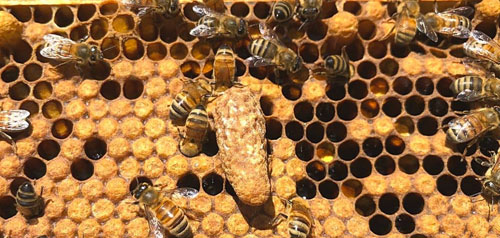Finding queen cells in your beehive is an important observation that beekeepers must address carefully, as it can indicate several different conditions or intentions within the colony. Here’s what you should consider and possibly do when you encounter queen cells:
1. Identify the Type of Queen Cells
First, identify the type of queen cells you’re seeing:
- Swarm cells are typically found at the bottom of frames and suggest that the hive is preparing to swarm.
- Supersedure cells are often located in the middle of frames and indicate the colony’s intention to replace the existing queen.
- Emergency cells are created when the existing queen is suddenly lost or failing, and these can appear anywhere on the comb.
2. Assess the Colony’s Condition
- Population and Space: Check if the hive is overcrowded, which could lead to swarming. Ensure there’s enough space for the colony to expand.
- Health of the Queen: Assess the current queen’s health and laying pattern. A failing queen or a significant reduction in egg laying can prompt the colony to raise a new queen.
3. Decide on a Course of Action
Depending on your assessment, you may decide to:
- Prevent Swarming: If you identify swarm cells and wish to prevent swarming, you could create a split or artificial swarm, removing some of the brood and bees with the old queen into a new hive. This simulates swarming and relieves congestion.
- Allow Supersedure: If the hive is making a supersedure cell, it’s often best to let the bees replace their queen naturally, as they’ve determined she is underperforming or failing.
- Address Emergency Needs: If there are emergency queen cells due to the sudden loss of a queen, ensure the hive has the resources it needs to successfully raise a new queen. Monitor the hive closely for the emergence of the new queen and her subsequent mating and egg-laying.
4. Monitor the Hive
After taking action, closely monitor the hive’s progress. Ensure the new queen is accepted, starts laying eggs, and that the colony returns to a healthy, productive state.
5. Considerations for Future Management
- Regular Inspections: Regular hive inspections can help you catch early signs of queen cell development and other issues, allowing for timely interventions.
- Space Management: Ensure your hive has enough space to grow to prevent overcrowding and swarming. Adding supers or brood boxes when needed can provide the necessary space.
6. Seek Advice
If you’re unsure about the best course of action, seek advice from experienced beekeepers or your local beekeeping association. They can offer insights specific to your situation and local conditions.
Handling queen cells requires a balanced approach, considering both the immediate needs of your colony and its future health and productivity.

